150 Years of Hemingrays 1848-1998
by Bob Stahr, Advertising through the Ages editor
Reprinted from "Crown Jewels of the Wire", June 1998, page 6
One hundred and fifty years ago on April 5, 1848, Ralph Gray and Robert
Hemingray formalized their partnership by signing their first lease. This lease
was for a piece of property in downtown Cincinnati, OH measuring 23' x 90'. This
small parcel was located on Hammond St. 150 feet north of 3rd St. and cost them
$250 per year. Exactly when glass blowing was started is not known, but it was
likely in the fall of 1848 since it would take the partners time to get
materials and equipment in order. Success at Gray & Hemingray was evident
early on when Ralph and Robert signed their second lease on August 12, 1850 for
an additional 27' x 90' adjacent lot for $150/year.

Cincinnati may not have been
their first choice however. Documentation shows that Gray and Hemingray were
interested in a parcel of land in Covington, KY as early as October 1847. Gray
and Hemingray hired M.M. Benton, a local lawyer, to perform the abstract of
title on property located at the northwest corner of 2nd and Madison St. The
first piece of property at this Covington location would later be acquired by
them on August 20, 1852. Gray and Hemingray may have planned this move from
Cincinnati to Covington since both Cincinnati leases expired on April 1, 1853.
The partnership continued to thrive for many years. Over the next three decades
additional land purchases surrounding the first Covington acquisition would
continue. Eventually, the glassworks would cover the entire corner. Several
minor company name changes would also occur during this time due to the deaths
of business partners including Ralph Gray in November of 1863. Products of the day included items such as lamps, bottles,
fruit jars, apothecary jars, flasks, and possibly insulators.
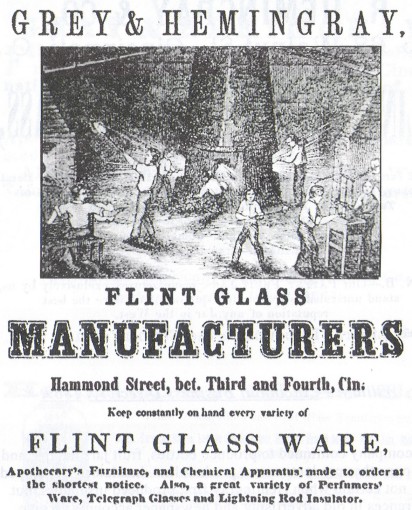
1851-52 advertisement from Gray's
Cincinnati Business Mirror & City
Advertiser.
Hemingray Glass
Co. was incorporated on March 21, 1870 by the General Assembly of the
Commonwealth of Kentucky. Officers at the time were Robert Hemingray, President;
James Foley, Vice President; and Richard Evans, Secretary.
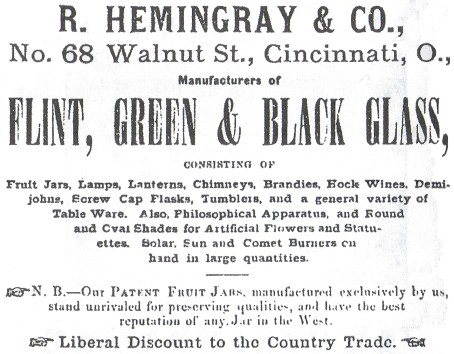
William's Cincinnati Business Directory. 1869.
As the company continued to produce bottles, fruit jars, lamps, and various
other products a new product line, insulators, developed. It is not certain when
Hemingray first produced insulators, but references in old advertising and
newspaper accounts do give clues. One source from 1851 mentioned "...
insulators, which are made for lightning rods and for telegraph lines..."
and another from 1859 indicated production of "Telegraph Glasses". If
production of pin type insulators occurred this early, they would certainly be
the threadless variety. In testimony for a patent infringement suit, it was
discovered that Hemingray first produced threaded insulators in the summer of
1868. Experimentation with this process led to the granting of the December 19,
1871 patent for threading insulators. The Covington factory would produce the
greatest amount of these early December 19, 1871 insulators but not all.
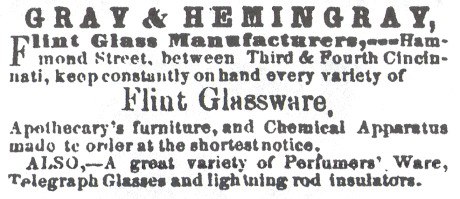
The Indiana American, Brookville, Franklin Co.,
Indiana. Friday July 8, 1853
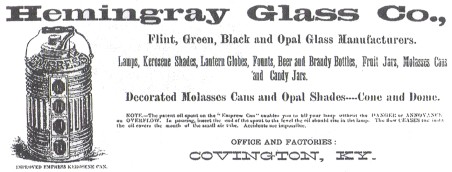
EMPRESS LANTERN AD --
Pottery & Glassware Reporter, Sept. 10, 1885.
(Courtesy of Dick Roller.)
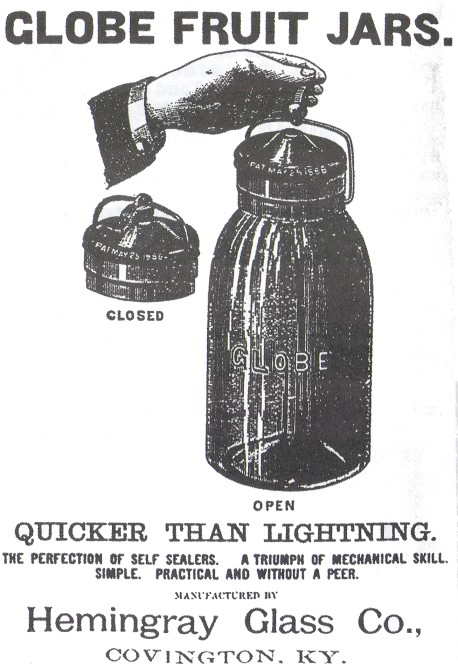
Large Image (177 Kb)
GLOBE FRUIT JAR AD --
Pottery & Glassware Reporter, June 21,1888.
(
Courtesy of Dick Roller.)
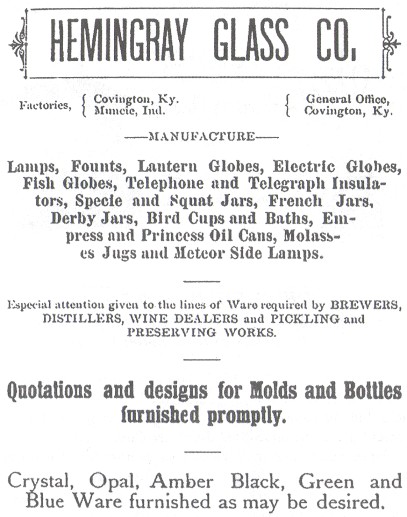
Pottery and Glassware Reporter, Sept. 13, 1888
(Courtesy Dick Roller)
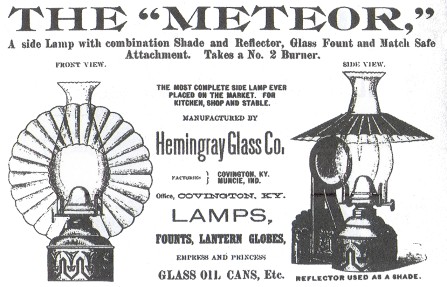
THE "METEOR" LAMP --
Pottery & Glassware Reporter, Aug 22 1889.
(Courtesy of Dick Roller.)
On December 10, 1887, Robert Hemingray signed an agreement with Manufacturers
Guarantee Fund Association of Muncie, Indiana to build a new factory there. As
part of the agreement it was promised that the entire Covington works would be
moved to that location as soon as possible. The promise of free natural gas to
use in melting glass and free land would make this decision elementary. Work on
construction of the plant located on Macedonia Avenue began immediately.
Sometime in 1888, glass production likely started with the some of the same
molds transferred from the Covington plant. Recent excavations at the Muncie
site support this theory. Dec 19, 1871 embossed insulators as well as kerosene
lamps, bottles, and fruit jars all made at this location mirror those made in
the last years of the Covington operation.
The Covington factory would not be
closed as soon as expected however. A disastrous fire would nearly destroy the
entire Muncie factory on June 18, 1892. A railroad switch engine was reported to
have thrown sparks onto packing straw stored in a railroad car at Hemingray's. Subsequent winds fanned the flames
to completely engulf both Hemingray's factory and the factory of the Over Window
Glass Co. Hemingray's Office and a couple of other storage buildings were the
only things left standing.
According to newspaper accounts of the fire,
Hemingray had a large insulator contract that they were filling for Western
Union when the fire broke out. Luckily, the glass furnace was not completely
destroyed and Hemingray was able to operate on a limited basis the day after the
fire. They would turn out two train carloads of insulators in the next week.
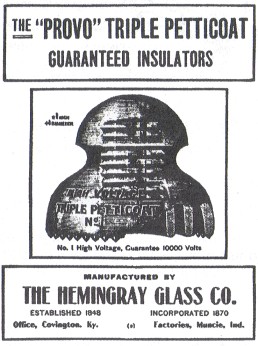
THE "PROVO" TRIPLE PETTICOAT
Electrical World and Engineer,
December 28,1901.
(Note insulator depicted is NOT a Provo type!)
Since the Covington Factory was still owned by Hemingray and rebuilding of the
Muncie plant would take time, Covington was revitalized. Evidence shows that
Hemingray operated the Covington plant through the fall of 1893 and possibly
into early 1894. This is known because archaeologists who excavated the
Covington site unearthed several hundred insulators bearing the May 2, 1893 patent date for drip points. The majority of
these insulators are Hemingray 9's and 12's. The March 1894 Sanborn Fire
Insurance Map of the Covington factory lists it as closed. This means that these
insulators were likely made between May 2, 1893 and March of 1894, a very small
window.
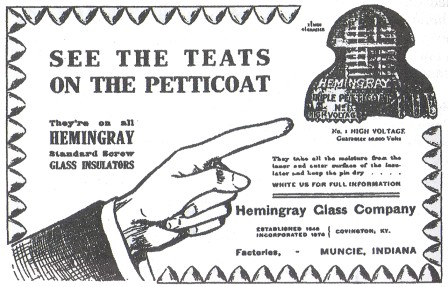
SEE THE TEATS ON THE PETTICOAT
Street Railway Review, 1907.
(Courtesy of Rick
Soller.)
After rebuilding the Muncie plant, Hemingray continued to operate at Muncie
manufacturing insulators, fruit jars, bottles, lamps, lamp shades, and battery
jars just to name a few. Disasters however would still occur. The office
building would succumb to fire in 1904 and its replacement would burn in 1927.
The newest Hemingray built office building still stands facing Macedonia Avenue
along with a limestone marker reading HEMINGRAY GLASS CO. and the date of 1927.
In the early 1910's Hemingray's production was chiefly insulators. It is not
known if Hemingray made bottles during this time, but it is likely. Because of
innovations in the automatic insulator machinery developed by Hemingray, extra
space became available for other production. Hemingray would use this extra
space to enter the bottle market again.
Prohibition started in 1920 and remained in effect until 1933. It was at this
time that Muncie was called "Little Chicago". Hemingray began
producing bottles on a large scale in 1925 by automatic equipment. Again, recent
excavations bear this out. Shards of refrigerator water bottles, pop and beer
bottles, vinegar bottles and jugs have all been found. The beer bottles would of
course contain prohibition type "near beers" containing less than 1/2 of
1 % alcoholic volume. Based on these excavations, it is evident Hemingray landed
some major accounts during this time. Over 50 bottlers from the Midwest and East
Coast have been identified including Blatz, Vess, Vernors, Hamm's and White
House Vinegar. A 1933 newspaper reported that Hemingray received an order for 500
train carloads of bottles due to the repeal of prohibition.
In May of 1933
Hemingray was sold to Owens-Illinois Glass Co. The report stated that
Owens-Illinois desired to obtain Hemingray's "unlimited Owens Bottle
License". This means that Hemingray produced bottles by a process patented
by the Owens Bottle Co. (Illinois Glass merged with Owens Bottle Co. in 1929 to
form Owens Illinois Glass Co.) It is likely that Owens-Illinois wanted to reduce
competition by acquiring Hemingray since they had the last remaining license not
under their control. It is rather strange that the owners of Hemingray would do
this knowing what a bright future lay ahead of them. The name Hemingray would
not disappear from this buyout however.
The Muncie plant would now become the
Hemingray Division of Owens-Illinois. Bottle production was shifted to other
Owens-Illinois plants while insulators would remain at Muncie. During 1933,
Owens-Illinois built a building at the Worlds Fair held in Chicago. This
building displayed products of theirs including bottles, metal cans, and other
assorted wares. It is not known however, whether insulators made it into the
exhibit. The building itself was an architectural wonder. The entire wall system
was composed of a revolutionary product that they called glass block. This glass
block was backlighted at night giving a spectacular show. Because of this
display, Owens-Illinois would receive thousands of orders for this new product.
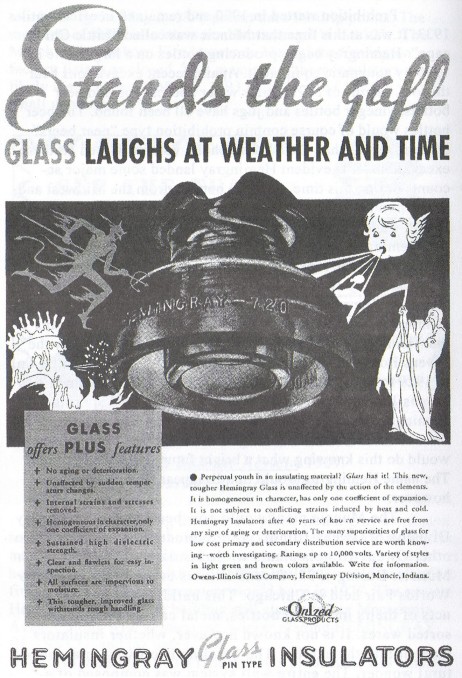
Large Image (245 Kb)
STANDS THE GAFF, Electrical World, January 5,1935.
Hemingray advertisement
during time that
Owens-Illinois owned the operation
touting the superiority of
their insulators.
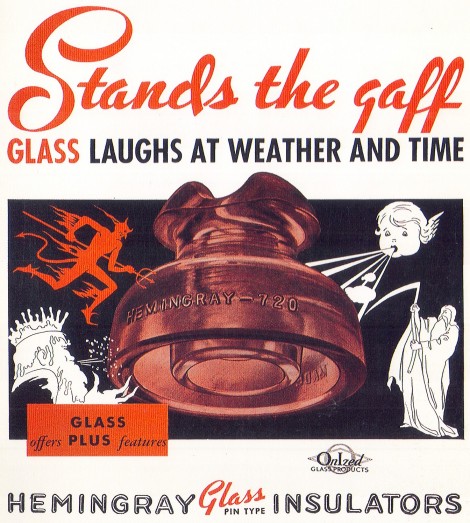
Large Image (208 Kb)
(Cover photo)
To supply the new glass block product, Owens-Illinois utilized the Hemingray
plant and its employees. By April of 1935, glass block production was shifted
from the Columbus, Ohio plant to Muncie. The employees' experience with pressing
insulators was one of the main reasons for moving the production.
Throughout the next few decades the Hemingray plant of Owens-Illinois would
continue to make such items as Hemingray insulators, glass blocks, glass land
mines for World War II, a few product jars, ice cream dishes, ashtrays, and
finally TV faceplates. In the early 1960's TV faceplate production was going
strong but the demand for glass block and Hemingray insulators was shrinking. In
1966, only four styles of insulators were being produced. These molds would
later be moved to Indiana Glass Co. in Dunkirk, IN where the very last Hemingray
insulators were produced in 1967. In 1969 the name Hemingray was dropped from
Owens-Illinois directories, yet the Muncie plant continued in operation. The
Muncie plant would not continue for very much longer however.
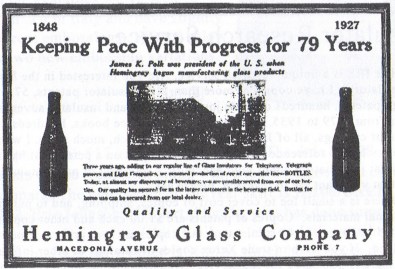
KEEPING PACE WITH PROGRESS FOR 79 YEARS
Original ad restored by Clarice
Gordon.
The Muncie Evening Press, Sept. 27, 1927.
Courtesy of Rosella Cartwright
and Muncie Public Library.
Advancements in the television industry brought about the color TV and
increased quality standards for the glass faceplates. On June 20, 1972 the
announcement was made that the Muncie Plant would be closed. It was cited that
because of its age and the expense required to rebuild the plant to meet new TV
faceplate needs, it was no longer of use to them. The plants official closing
was on July 15, 1972. Some employees remained to fill orders and keep a watch
over the factory until it was finally sold. Most of the factory including the
glass furnaces still stands today and is currently being used as a storage
facility. I had the opportunity to tour the plant and actually crawl inside one
of the furnaces which still contains the last glass ever produced at the Muncie
plant. It was very interesting that someone marked the date 8/2/72 on the inside
wall of the furnace. This was likely the last time someone was inside the
furnace until I visited it 25 years later. The factory would never again make
glass, but collectors would forever cherish the products of this company started
150 years ago by a man named Hemingray.
| 